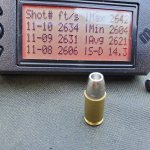Is there a source for calculations to determine the optimal barrel length for a given cartridge?
I've searched the forums but I didn't find a source for the formulas.
I'm not smart enough to figure this out myself, but I think I am smart enough to understand the formulas if can find them.
Any assistance would be appreciated.
I've searched the forums but I didn't find a source for the formulas.
I'm not smart enough to figure this out myself, but I think I am smart enough to understand the formulas if can find them.
Any assistance would be appreciated.




